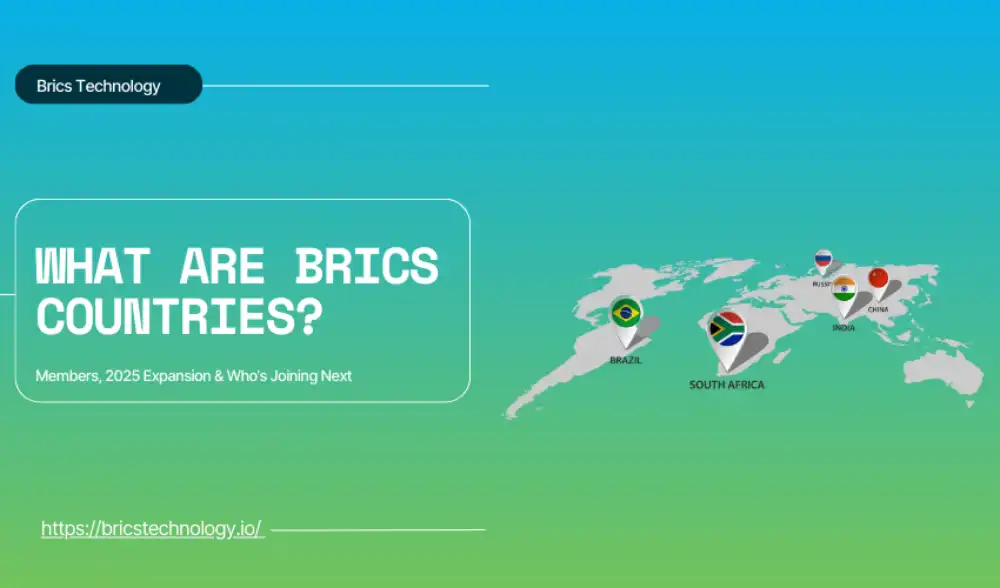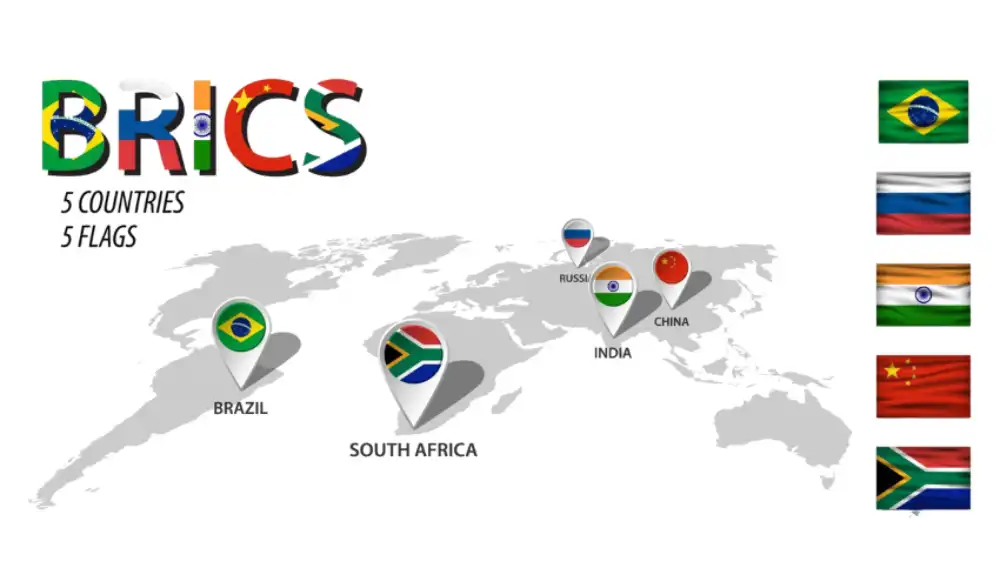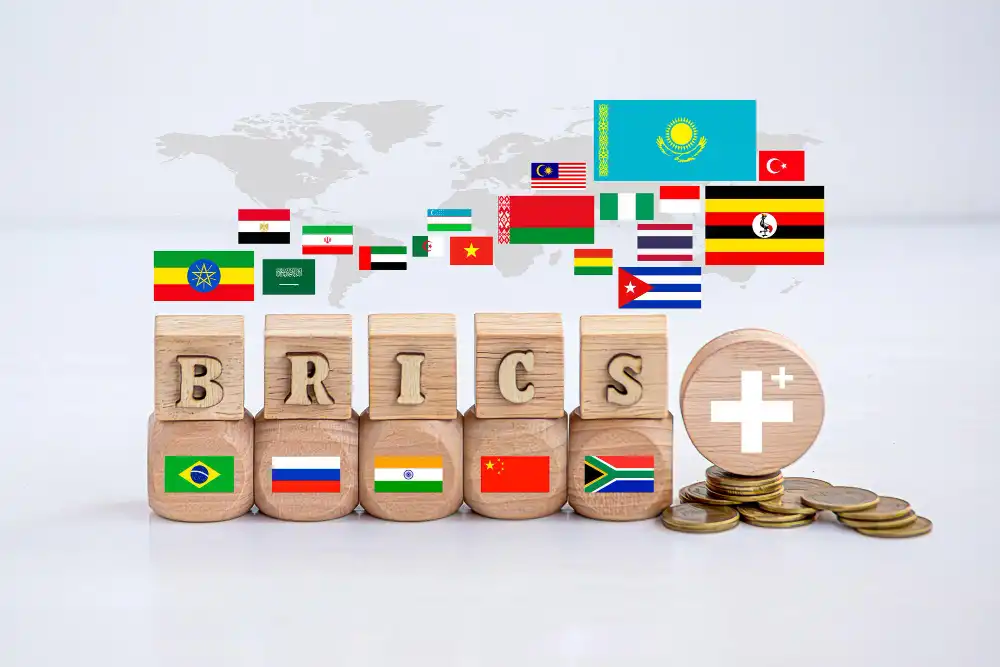What Are BRICS Countries? Members, 2025 Expansion & What's Next

What started as a loose economic alliance between Brazil, Russia, India, China, and South Africa is now transforming into something much bigger. This alliance is not a result of short-term collaboration. However, talks between these countries have been ongoing since the early 2000s.
Jim O’Neill, a researcher at Goldman Sachs, published a paper in 2001 claiming that the four big economies Brazil, Russia, India, and China were trying to reshape the world economy in the upcoming years.
A few years later, these countries formed the BRICS alliance in 2006. Three years later, they held the first summit in 2009 in Yekaterinburg, Russia. Later, in 2010, South Africa also joined the alliance. The name comes from the initial letters of each of the founding countries. After joining the new countries, this alliance is now known as BRICS+.
With new members joining and others eyeing the group, BRICS is no longer just a club of emerging economies. It is becoming a serious counterweight to Western-led systems.
This shift occurs when trust in global financial systems is shifting. Sanctions, trade wars, and shifting alliances have sparked a growing demand among nations to explore alternatives. The rise of BRICS offers that possibility. But who are these countries, what do they want, and why does it matter now more than ever?
This article breaks down the complete list of BRICS countries, the expansion timeline through 2025, why some nations are joining while others hesitate, and what it all could mean for the U.S. and the global financial order.
What Are BRICS Countries?

BRICS is an acronym for five major emerging economies: Brazil, Russia, India, China, and South Africa. The group was initially formed as “BRIC” in 2006, with South Africa officially joining in 2010. Together, these nations represent a significant portion of the world’s population and economic potential.
The idea behind BRICS was never just economic cooperation. It emerged as a strategic move by these countries to challenge the dominance of Western-led institutions, especially in global finance and trade. At a time when the United States and Europe heavily influenced institutions like the IMF and World Bank, BRICS pushed for a more balanced global order. One that gave a greater voice to developing nations.
Over time, BRICS evolved from a discussion platform to a functional alliance. The group now hosts annual summits and coordinates on diplomatic and financial policies. It launched its development bank, the New Development Bank (NDB), in July 2015 to fund projects independently of Western economic systems. At that time, the bank had an initial capitalisation of $50 billion.
Before the NDA, they established the Contingent Reserve Arrangement (CRA) in 2014. This institution initially received $100 billion in funding. It was designed to support nations facing economic challenges by providing them with accessible financial resources.
The difference between these two institutions is that, in NDA, every BRICS nation has an equal share. However, in the CRA, every member nation is not required to contribute equally. For example, China provided 41% of the initial assets.
While the group is diverse in geography, culture, and politics, BRICS nations share a common vision:
- Reducing dependence on the U.S. dollar
- Reshaping how global power is distributed
BRICS Countries List: 2024 & 2025
BRICS began as a small group of major emerging economies: Brazil, Russia, India, China, and later, South Africa. These five nations shared a vision to reshape global governance and reduce the dominance of Western-led institutions. Over the years, their growing economic and political weight turned BRICS into more than just a partnership. It became a platform for challenging the status quo. The following founding nations started the alliance.
Founding Members
- Brazil
- Russia
- India
- China
- South Africa (joined in 2010)
New Members (Joined in 2024)
In 2023, the group took a bold step forward. At the 15th BRICS Summit in August 2023, in Johannesburg, leaders of the BRICS nations extended formal invitations to six new countries. By January 1, 2024, four of the invited nations officially joined:
- Egypt
- Ethiopia
- Iran
- United Arab Emirates (UAE)
Recent Addition (Joined in 2025)
Most recently, one more Asian country joined the alliance in January 2025.
- Indonesia
Indonesia’s membership became effective on January 6, 2025. It became the first Southeast Asian nation to join the alliance.
Pending Membership and Withdrawal
- Saudi Arabia was invited to join BRICS in 2023 but has not yet confirmed its membership as of early 2025. They did not withdraw from BRICS and joined other nations at the summit or other discussions, but have not officially joined. We will see why in the next section.
- Argentina initially accepted the invitation to join BRICS but officially declined membership in December 2023. What made them withdraw? We will see in the next section.
Partner Countries (As of January 2025)
In addition to full members, BRICS has established a “partner country” status. This status allows nations to engage with the bloc without full membership. As of January 2025, the following nine countries have joined the BRICS countries 2024 as partners:
- Belarus
- Bolivia
- Cuba
- Kazakhstan
- Malaysia
- Nigeria
- Thailand
- Uganda
- Uzbekistan
BRICS Economic and Demographic Snapshot: Facts and Figures
BRICS (Brazil, Russia, India, China, South Africa) collectively represent a powerful economic bloc, comprising nearly one-third of global GDP on a Purchasing Power Parity (PPP) basis. Their combined nominal GDP accounts for roughly 23.6% of the global economy.
With a population of approximately 3.9 billion, accounting for about 48% of the world’s population, the BRICS member countries hold significant demographic and economic influence. The intra-BRICS trade has reached approximately $1.2 trillion, underlining deepening regional economic cooperation. Forecasted GDP growth across BRICS is around 4–6% annually (2025–2030), driven by increased urbanization, technological advancements, and infrastructure expansion.
BRICS Economic & Demographic Overview (2024–2025)
| Metric | Data / Figure |
| Nominal GDP (Share of World) | ~23.6% |
| GDP PPP (Share of World) | ~31.5–32% |
| Combined GDP (PPP) | Approx. US $65 trillion |
| Total Population | 3.9 billion (~48% of global population) |
| Intra-BRICS Trade Volume | Exports: $497 billion; Imports: $708 billion |
| Average Annual GDP Growth (2025–2030) | 4–6% annually (average across member countries) |
2025 Expansion: New Members Who Joined
In January 2024, the BRICS group expanded to include four new countries: Egypt, Ethiopia, Iran, and the United Arab Emirates (UAE). Previously, the group had only five members: Brazil, Russia, India, China, and South Africa. This expansion was an essential step in increasing BRICS’s role in global affairs and giving growing economies a platform to collaborate on economic and political issues. This update made headlines in recent BRICS news.
Possible Reasons for the Addition of New Countries
Egypt: As one of North Africa’s strongest economies, Egypt adds value to BRICS. Its location helps connect the group more closely to African and Middle Eastern markets, making cooperation and trade easier.
Ethiopia: Ethiopia brings fresh opportunities to BRICS. Its position in the Horn of Africa also helps strengthen the group’s influence.
Iran: has vast energy resources and plays a significant role in the global energy market. By joining BRICS, Iran gains a new space to work with international partners, especially when it faces pressure from Western sanctions.
United Arab Emirates (UAE): With its strong and diverse economy, the UAE has much to offer. As a significant global trade centre, it helps open up more opportunities for business, trade, and investment across the BRICS countries.
The Argentina Twist: From Joining to Backing Out
In December 2023, Argentina reversed its earlier decision to join the BRICS alliance. As of January 1, 2024, the country had been among six nations invited to join. However, this changed when Javier Milei became Argentina’s new president. His administration informed BRICS leaders that joining the bloc no longer aligned with the country’s foreign policy priorities.
President Milei’s government signalled a shift in international strategy. It focused on strengthening ties with the U.S. and Israel rather than aligning with alternative global groupings. This decision marked a sharp turn from the previous administration, which had supported BRICS membership.
Argentina’s exit from the upcoming expansion showed that even invited members may reassess their place in such blocs based on changing national interests and diplomatic directions.
The Saudi Factor: In or Out?
Saudi Arabia’s position in the BRICS alliance remains unclear. Although it was named one of six nations invited to join in August 2023, the kingdom has not officially confirmed its full membership. According to BRICS news sources and statements from South African officials, Saudi Arabia expressed strong interest during the 2023 summit. However, as of early 2025, no formal announcement has been made.
This ambiguity has sparked debate among analysts. Some believe Saudi Arabia is weighing its geopolitical ties, especially with Western allies, before committing to a bloc often seen as a counterbalance to the U.S.-led order. Others argue that it seeks assurances on trade, oil pricing, and financial systems, like BRICS Pay, before fully stepping in.
If confirmed, Saudi Arabia’s inclusion would significantly boost BRICS’ energy dominance and global economic influence. Its participation could also strengthen efforts to promote alternative currencies and reduce reliance on the U.S. dollar.
Which Countries Want to Join BRICS in 2025

As BRICS continues to grow, many developing nations seek membership to gain more influence in global finance and reduce reliance on Western institutions. The bloc’s push for a multipolar world has recently attracted many applicants. According to statements by South African and Russian officials, over 20 countries have formally submitted applications or expressed strong interest in joining BRICS.
Here is a list of the most talked-about applicants so far:
- Algeria
- Bahrain
- Bangladesh
- Belarus
- Cuba
- Kazakhstan
- Nicaragua
- Nigeria
- Pakistan
- Senegal
- Thailand
- Tunisia
- Turkey
- Venezuela
- Vietnam
- Zimbabwe
Inside BRICS: Political Dynamics, Tensions, and Alliances
While BRICS projects unity externally, internal dynamics tell a nuanced story. Tensions between China and India, notably the ongoing border disputes along the Line of Actual Control (LAC), create friction within the group.
Brazil, under President Lula da Silva, advocates for increased autonomy from U.S. influence, yet maintains strong Western economic ties, reflecting internal ideological diversity. Russia’s invasion of Ukraine further complicates unity, as BRICS members differ sharply.
India and China remain neutral or supportive towards Russia, while Brazil and South Africa express cautious diplomatic neutrality. These internal divisions challenge BRICS’ cohesion, impacting their collective influence at forums like the G20 and United Nations.
Internal Tensions and Alliances:
- China-India Border Clashes: Major incidents in Ladakh (2020–2023) strained diplomatic relations.
- Russia-Ukraine Conflict (2022–ongoing): Diverse responses among members reflect internal fragmentation.
- Brazil’s diplomatic balancing act: Lula’s administration pushes multipolarity but maintains robust trade with Western allies.
BRICS Currency Countries: Economic Influence of Members
The push for a new BRICS currency is not coming from all directions equally. Among the bloc’s members, China and Russia are leading the charge. China brings its massive manufacturing power and global trade presence. Russia is currently facing Western sanctions, which have become one of the loudest voices that promote alternatives to the U.S. dollar. Both nations are strategically aligned in favor of building a system that weakens dollar dominance.
India and Brazil play a more cautious role. While supportive of strengthening BRICS cooperation, they are wary of fully embracing a new joint currency without clear rules and mutual benefits. South Africa supports greater trade within the bloc but has economic constraints that limit its role in currency development.
Key economic influence of BRICS members:
- BRICS countries represent over 40% of the global population
- They account for a rising share of global GDP
- China alone contributes over 18% of global output (in purchasing power parity)
- Many members are trading in local currencies to reduce dependence on the U.S. dollar
- Russia and Iran are using BRICS alternatives to minimise the impact of Western sanctions
Will the BRICS Currency Challenge U.S. Dollar Dominance?
While BRICS nations are pushing for a currency alternative, replacing the U.S. dollar entirely is difficult. The dollar dominates over 80% of global trade and nearly 60% of foreign exchange reserves. No BRICS currency currently has the liquidity, trust, or international reach to compete at that level.
However, if more countries begin trading in local currencies or a future BRICS currency gains backing from gold or other reserves, it could gradually reduce the dollar’s influence, especially in regions tired of U.S. financial control.
Rather than a complete replacement, the more realistic outcome is a dual-system world, where the dollar and a BRICS-led system operate in parallel. That shift is already unfolding in trade agreements and central bank discussions.
For a deeper look into how BRICS plans to challenge the dollar’s dominance, check out our article on BRICS vs US Dollar.
BRICS Financial Institutions and Strategic Initiatives
BRICS nations have developed robust financial frameworks aimed at enhancing economic resilience and global influence. Central to these efforts is the New Development Bank (NDB), which has approved over $30 billion in infrastructure and sustainability projects across member states.
Additionally, the Contingent Reserve Arrangement (CRA), valued at $100 billion, provides emergency financial liquidity, promoting financial stability. Strategic moves, such as BRICS Pay, highlight their ambition to integrate payment systems and potentially introduce a unified digital currency or cryptocurrency to reduce their dependency on the US dollar.
Be Active, Stay Connected to know What’s Next?
The BRICS alliance is no longer just a headline. It is a wake-up call. With new members joining, more countries lining up to apply, and a growing push to reduce reliance on the dollar, the balance of global power is shifting quietly but steadily.
This is not just about politics or currencies. It’s about the everyday impact on markets, investments, and your wallet’s dollar value. A world where BRICS nations trade in their currencies could mean rising costs, shifting alliances, and a different financial landscape.
No, the dollar is not going to disappear tomorrow. But for the first time in decades, it is facing real competition.
Frequently Asked Questions
The BRICS nations aim to expand their global influence through new memberships, stronger trade ties, and steps toward reducing dependence on the U.S. dollar.
More than 20 countries, including Algeria, Bangladesh, and Nigeria, have formally applied to join BRICS, hoping to be part of a multipolar world order.
A future BRICS currency could challenge the dollar’s global dominance, particularly in trade and reserve holdings, shifting economic power toward emerging markets.
Catagories
Recent Post
- Tired of Disconnected Systems? How Cloud Telephony + CRM Improves Efficiency
- Stealthly AI: Transforming AI Content into Authentic Human Text
- Why Weighted Grade Calculators Matter for Accurate Academic Planning
- Customize Your Phone Sound with a Free Online Ringtone Maker
- How to Use AI in Stock Trading for Smarter Decisions
